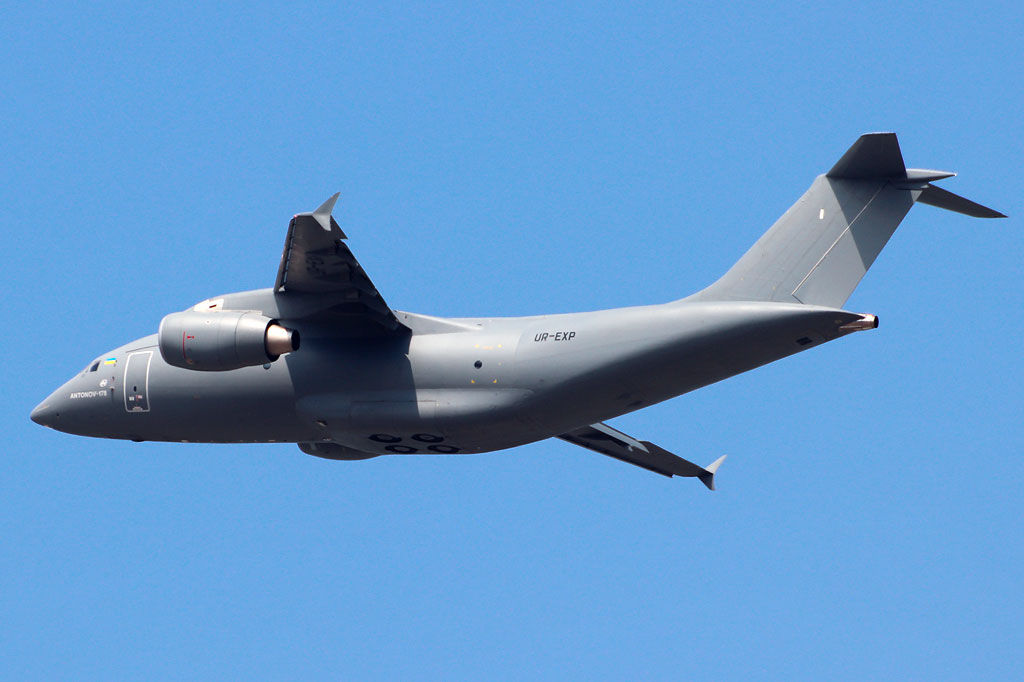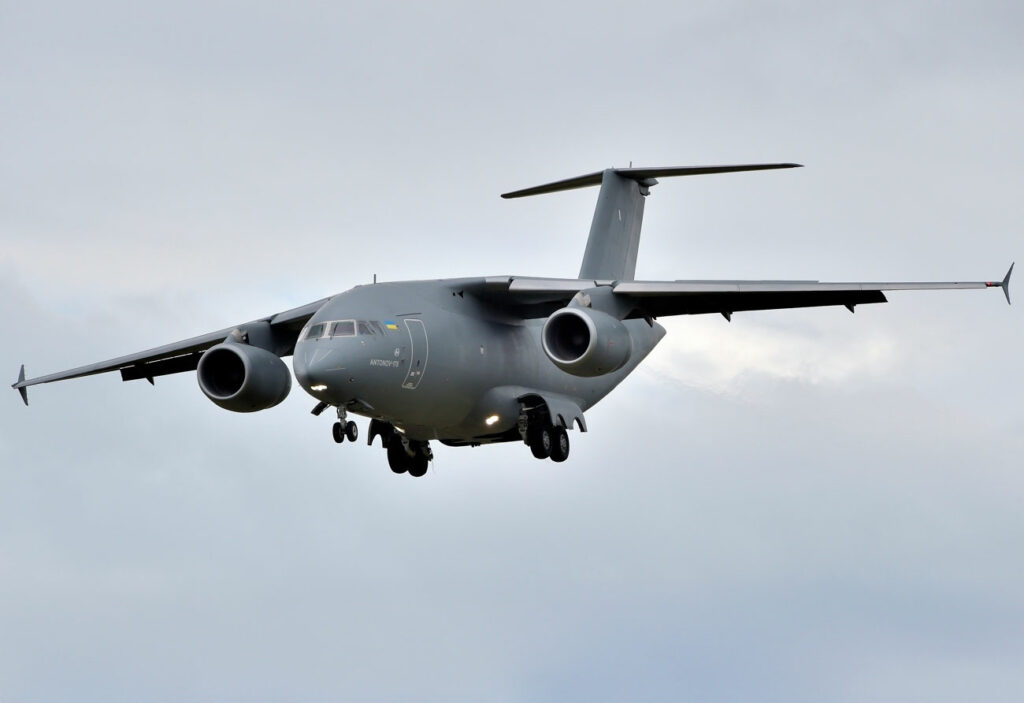The Antonov An-178 is a medium transport aircraft designed for military and civil operations, capable of carrying up to 18 tons of cargo over 1,000 km.
The Antonov An-178 is a twin-engine turbofan transport aircraft developed by the Ukrainian company Antonov. Designed to replace older models like the An-12, An-26, and An-32, it features a high-wing configuration with a T-tail and winglets. The aircraft is powered by two Progress D-436-148FM engines, each providing a thrust of approximately 16,534 pounds-force (73.55 kN). It has a maximum payload capacity of 18 metric tons (39,683 pounds) and can transport this load over a distance of 1,000 kilometers (621 miles). With a cruising speed of 825 km/h (513 mph) and a service ceiling of 12,200 meters (40,026 feet), the An-178 is suitable for various missions, including cargo transport, troop deployment, and medical evacuation. Its cargo compartment is designed to accommodate standard 1C containers measuring 2.44 by 2.44 meters (8 by 8 feet), enhancing its versatility in logistics operations.
History of the Development of the Antonov An-178
In the early 2010s, the global aerospace industry recognized the need to modernize medium-lift transport fleets. Existing aircraft like the Antonov An-12, An-26, and An-32, which had been in service since the mid-20th century, were becoming outdated in terms of technology, fuel efficiency, and operational capabilities. To address this gap, Antonov initiated the An-178 program in 2010, aiming to develop a state-of-the-art transport aircraft that could meet both military and civilian needs.
The primary objective was to create an aircraft capable of transporting up to 18 tons of cargo, including standard 1C containers, over medium-range distances. This capability would enhance logistical efficiency, especially in regions lacking advanced infrastructure. The design also emphasized versatility, allowing for rapid reconfiguration to accommodate troops, paratroopers, or medical evacuation setups.
Antonov leveraged its experience from previous models, particularly the An-148 and An-158, to inform the An-178’s design. This approach facilitated the integration of proven technologies and design elements, expediting the development process. The project was led by Antonov’s then-General Designer, Dmytro Kiva, who had been at the helm since 2005.
The An-178’s maiden flight occurred on May 7, 2015, marking a significant milestone in Ukrainian aviation. The prototype took off from Antonov’s airfield in Kyiv, piloted by a crew led by test pilot Andriy Spasibo. The flight lasted approximately one hour, during which the aircraft’s basic handling and performance characteristics were evaluated.
Following its first flight, the An-178 was showcased at several international airshows to attract potential customers and demonstrate its capabilities. In June 2015, it was presented at the International Paris Air Show in Le Bourget, where it garnered attention for its modern design and versatility. Later that year, in November, the aircraft participated in the Dubai Airshow, further establishing its presence in the global aerospace market.
The An-178 was developed without a NATO reporting name, as it was introduced after the dissolution of the Soviet Union, during which NATO assigned such codenames to Soviet military aircraft.
In terms of orders and production, the An-178 secured interest from various international customers. In 2015, Azerbaijan’s Silk Way Airlines signed a contract for the delivery of ten An-178 aircraft, aiming to enhance their cargo capabilities. Additionally, in December 2015, a memorandum of understanding was signed with Saudi Arabia’s Taqnia Aeronautics Company for the potential delivery of thirty An-178s for the Royal Saudi Air Force.
Despite these promising developments, the An-178 program faced challenges, particularly concerning the sourcing of components. The initial prototypes incorporated parts produced in Russia, which became problematic following geopolitical tensions and subsequent sanctions. To mitigate this, Antonov undertook efforts to replace Russian-made components with alternatives from Ukrainian and Western suppliers. By December 2021, the company announced that the An-178 no longer contained Russian-made parts, with components now sourced from Ukraine, the United States, the European Union, and Canada.
The Ukrainian government also recognized the strategic importance of the An-178 for national defense. In late 2020, a state order was placed for the construction of three An-178 aircraft for the Ukrainian Armed Forces, marking the first such order in Ukraine’s modern history. By December 2021, the first of these aircraft was presented, signifying progress in bolstering Ukraine’s military transport capabilities.
Throughout its development, the An-178 has been positioned as a versatile and modern solution for medium-lift transport needs. Its design reflects a blend of proven aeronautical principles and contemporary technologies, aiming to meet the diverse requirements of both military and civilian operators in the 21st century.

Design of the Antonov An-178
The Antonov An-178 features a high-wing monoplane design with a T-tail configuration and winglets, optimizing aerodynamic efficiency and stability. The airframe is constructed using a combination of aluminum alloys and composite materials, resulting in a semi-monocoque fuselage with a circular cross-section. This construction provides a balance between structural integrity and weight reduction, enhancing overall efficiency and payload capacity.
Fuselage and Cargo Bay
The An-178’s fuselage is derived from the Antonov An-148 regional jet, but features a modified structure to accommodate cargo transport. The cargo bay has a volume of 125 m³ (4,415 ft³), allowing it to carry up to 18 metric tons (39,683 lbs) of payload. It is equipped with a rear ramp for easy loading and unloading, particularly for military vehicles, pallets, and standard 1C ISO containers measuring 2.44 x 2.44 m (8 x 8 ft). This capability makes it a direct competitor to the C-27J Spartan and the Embraer KC-390.
Wings and Aerodynamics
The high-mounted wings enhance ground clearance and provide better lift-to-drag characteristics. They incorporate winglets, reducing induced drag and improving fuel efficiency. The wingspan measures 28.84 m (94.65 ft), and they house integral fuel tanks that contribute to the aircraft’s operational range.
Cockpit and Avionics
The cockpit is fully digital, equipped with a glass cockpit system developed by Antonov and Ukrainian aerospace suppliers. It features five large LCD multifunction displays, providing pilots with navigation, engine monitoring, and mission-specific data. The aircraft also incorporates an autopilot system, reducing pilot workload during long-haul operations.
For night and adverse weather operations, the An-178 is equipped with a head-up display (HUD) system, a weather radar, and terrain awareness and warning systems (TAWS). The avionics suite is designed for compatibility with NATO standards, making it easier for international customers to integrate the aircraft into their fleets.
Landing Gear and Short Takeoff Capability
The An-178 features a tricycle landing gear, with a twin-wheel nose landing gear and two main landing gear units, each with two wheels. It is designed to operate from unprepared runways, including grass, gravel, and dirt strips, making it suitable for military and humanitarian operations in remote areas.
Materials and Structural Efficiency
The An-178 incorporates composite materials in the airframe, particularly in non-load-bearing areas, to reduce weight and improve corrosion resistance. Aluminum alloys dominate the structure, ensuring high strength and ease of maintenance.
Advancements Over Previous Models
Compared to the An-12 and An-26, the An-178 offers:
- Better fuel efficiency through modern turbofan engines.
- Higher payload capacity with containerized cargo compatibility.
- Reduced operational costs due to fewer crew requirements (two pilots vs. larger crews on older aircraft).
- Improved aerodynamics with winglets and a more efficient fuselage shape.
However, drawbacks include:
- Limited customer adoption due to geopolitical issues and competition from Western aircraft.
- Dependence on foreign components, which required reengineering after Russia-Ukraine tensions.
Performance of the Antonov An-178
The An-178’s performance metrics place it within the category of medium transport aircraft, competing with models like the Lockheed C-130J Super Hercules, C-27J Spartan, and Embraer KC-390.
Engines and Powerplant
The An-178 is powered by two Progress D-436-148FM turbofan engines, manufactured by Motor Sich and Ivchenko-Progress. Each engine produces a thrust of 16,534 lbf (73.55 kN). These engines were originally developed for regional jets but were adapted for the An-178 to provide higher fuel efficiency and reduced noise emissions.
The engine nacelles are optimized for low drag, improving overall performance. The An-178 features an auxiliary power unit (APU), allowing it to operate independently from ground support equipment, especially in austere environments.
Speed and Altitude
- Cruising speed: 825 km/h (513 mph; 445 knots)
- Maximum speed: 850 km/h (528 mph; 459 knots)
- Service ceiling: 12,200 m (40,026 ft)
Compared to its competitors:
- The C-27J Spartan has a max speed of 602 km/h (374 mph), making the An-178 significantly faster.
- The KC-390 cruises at 870 km/h (541 mph), giving it a slight speed advantage over the An-178.
Range and Fuel Efficiency
- Ferry range (empty): 5,300 km (3,293 miles)
- Range with max payload (18 tons): 1,000 km (621 miles)
The aircraft’s range is optimized for regional transport, similar to the C-27J and C-295, but significantly lower than the KC-390, which can fly 2,815 km (1,750 mi) with a 23-ton payload.
Payload and Cargo Handling
- Maximum payload: 18,000 kg (39,683 lbs)
- Cargo bay volume: 125 m³ (4,415 ft³)
- Container compatibility: Standard 1C ISO containers can fit directly.
Its ability to carry large containerized cargo gives it an edge over non-containerized designs like the C-130J.
Variants of the Antonov An-178
There are currently two known versions of the An-178:
- An-178-100R (Standard variant): Military cargo transport with modifications to exclude Russian components.
- An-178-111 (Potential NATO version): Designed to comply with NATO logistics requirements, though no formal customers have been announced.

Military Use and Combat of the Antonov An-178
While the An-178 has not yet been used in combat, it is being procured by the Ukrainian Air Force and has received interest from foreign military operators.
Armament and Defensive Systems
The An-178 does not carry offensive weapons, but it is equipped with:
- Countermeasure dispensers for chaff and flares to counter heat-seeking and radar-guided missiles.
- Radar warning receivers for detecting threats.
- Military-grade communication and navigation systems for tactical deployments.
Operational Deployments
The An-178 has been marketed for:
- Military transport (troops, equipment, paratroopers).
- Humanitarian aid (natural disaster response, emergency relief).
- Medical evacuation (ambulance aircraft configuration).
In 2021, the Peruvian Ministry of the Interior ordered one An-178-100P, intended for military transport and disaster relief.
Current Operators
As of 2024, the confirmed military operators are:
- Ukrainian Armed Forces (3 aircraft on order).
- Peruvian National Police (1 aircraft ordered).
Competitors
- Lockheed C-130J Super Hercules (larger payload, longer range).
- C-27J Spartan (similar payload, but slower).
- Embraer KC-390 (more range and speed, but higher costs).
Future Prospects
The An-178 program faces competition from NATO-aligned aircraft, but its affordable operational costs and containerized cargo capability make it an attractive option for nations with limited budgets.
The Antonov An-178 is a modern medium-lift transport aircraft, offering good cargo capacity, modern avionics, and adaptability for both civil and military use. Its high-speed performance surpasses some competitors, but its range limitations restrict it to regional operations. With ongoing geopolitical challenges, its future largely depends on securing additional international customers and ensuring long-term production viability.
Back to Transport planes.